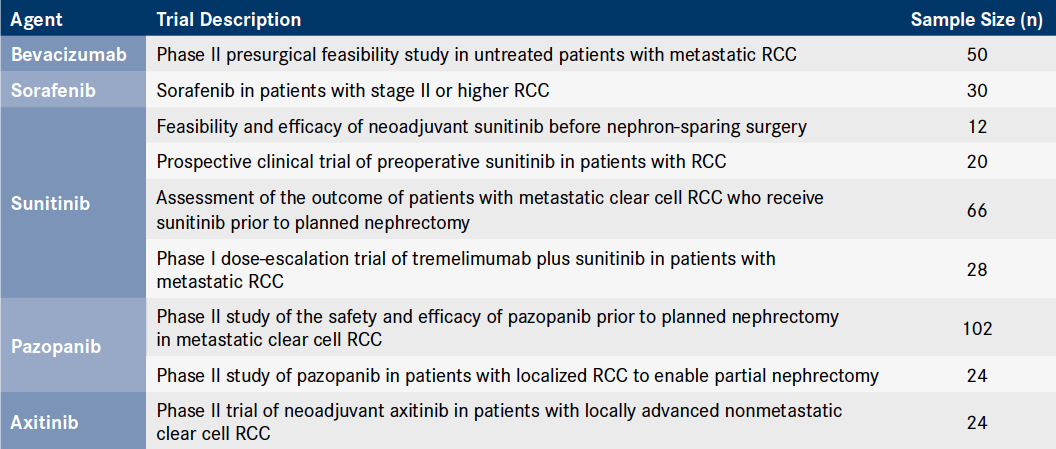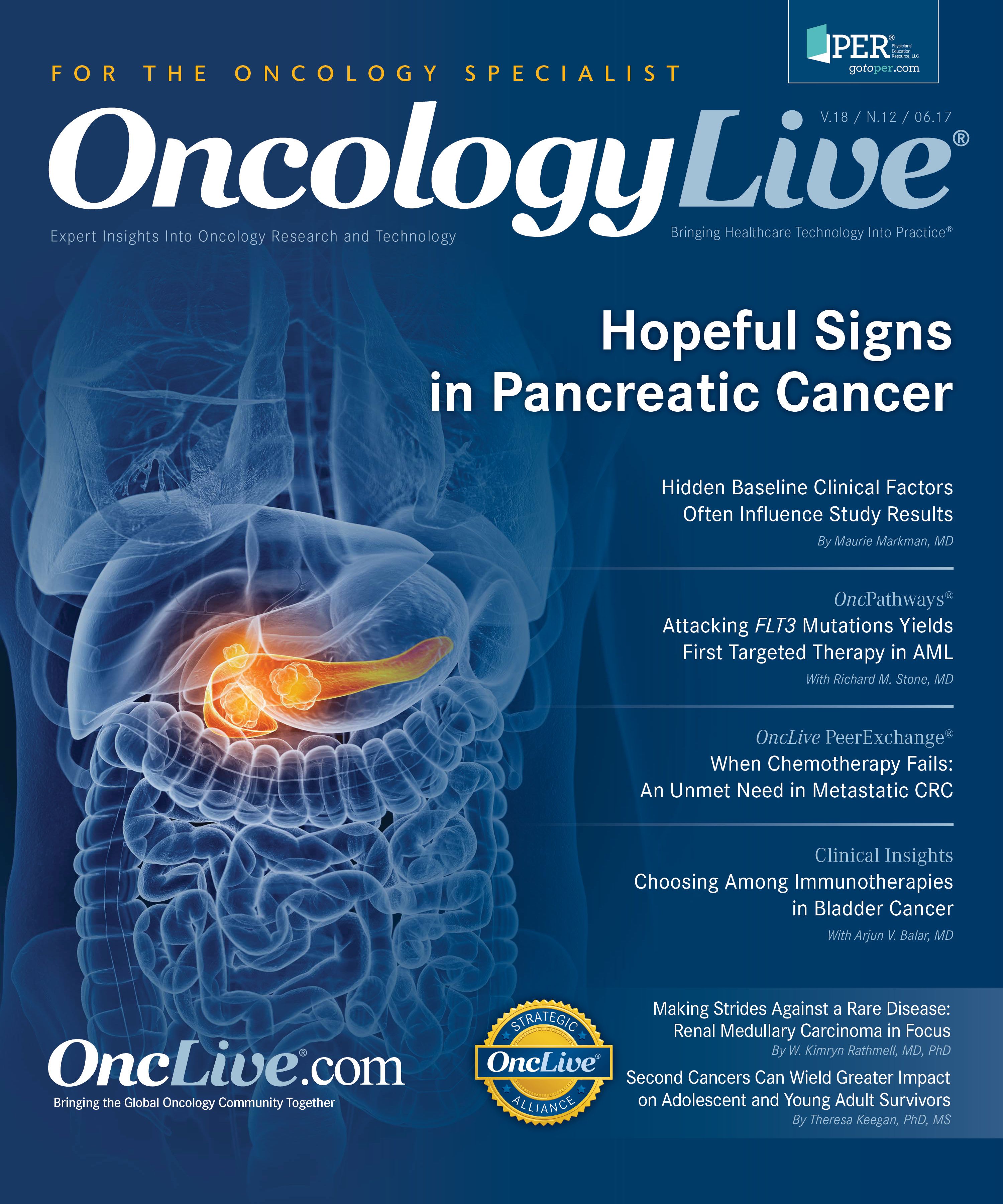Publication
Article
Oncology Live®
Evolving Neoadjuvant and Adjuvant Therapeutic Approaches in RCC
Author(s):
Surgical resection, including cytoreductive nephrectomy, remains the standard of care for most patients with renal cell carcinoma, but many patients will have a recurrence, and could benefit from additional therapy.
David M. Nanus, MD, a medical oncologist at Weill Cornell Medicine

David M. Nanus, MD
Role of Neoadjuvant Therapy
Surgical resection, including cytoreductive nephrectomy, remains the standard of care for most patients with renal cell carcinoma (RCC). However, many patients will have a recurrence, and could benefit from additional therapy. Much research has been conducted to define the role of neoadjuvant and adjuvant therapies for patients with RCC, but the standard of care has not changed significantly in the past several years.“The [benefit] of giving therapy, like a TKI for instance, would be to start systemic therapy right away, have the tumor shrink, so the nephrectomy will be easier,” said David M. Nanus, MD, during a presentation at the New York GU™: 10th Annual Interdisciplinary Prostate Cancer Congress® and Other Genitourinary Malignancies that Physicians’ Education Resource® (PER®) hosted March 18 in New York City.
Nanus said that rapid initiation of systemic therapy prior to surgery could also decrease cancer-related mortality, and could eliminate these risks in patients who would not benefit from a nephrectomy. “The contrast to that is that it may add to the morbidity or mortality of surgery if you give the drug; there may be wound-healing issues, and you may ‘decondition’ the patient and [then] they can’t get systemic therapy. And it hasn’t been proven that it improves survival, so why should we do it,” commented Nanus, a Mark W. Pasmantier Professor of Hematology and Oncology in Medicine, Weill Cornell Medicine.
Table 1.Selected Prospective Neoadjuvant Trials in RCC

Previously there were several prospective clinical trials in the neoadjuvant setting prior to cytoreductive nephrectomy (Table 1), but such investigations have become less frequent due to the recent push for developing immunotherapies. One such study Nanus mentioned was a phase II study of pazopanib (Votrient) in patients with localized RCC to optimize preservation of the renal parenchyma.1 Of the 13 patients originally unable to undergo a partial nephrectomy, 6 underwent surgery. Significant decrease in the size of the tumors occured in the patients. “Keeping a patient from going on dialysis by shrinking the tumor preoperatively should be done,” Nanus commented.
In another phase II study assessing the safety and efficacy of pazopanib therapy prior to a planned nephrectomy in patients with metastatic clear cell RCC (ccRCC), investigators discovered that a nephrectomy could be performed safely after upfront treatment with pazopanib and was associated with good outcomes in patients with intermediate-risk disease.2 A significant size reduction in the primary tumor was observed, with a median reduction of 14.4% (range, 1.4%-21.1%).
Role of Adjuvant Therapy
Table 2.Selected Phase III Clinical Trials for Agents in the Adjuvant Setting for RCC

“However, when you look at progression-free survival, in this study it was about 7 months, so it’s not very clear that giving preoperative [pazopanib]in the metastatic setting made a big difference,” Nanus said. “I think giving cytoreductive neoadjuvant therapy should be restricted to select patients.”“There was no prospective randomized trial in the cytokine era that clearly demonstrated a benefit with adjuvant therapy,” Nanus said. “But obviously, there’s still a need for adjuvant therapy studies.” Nanus further explained that patients tend to relapse at high rates, with a tendency toward mortality for those who progress to metastatic disease. Patients in these populations could benefit from an adjuvant treatment if one were proven effective (Table 2), but investigations into adjuvant treatments have had several trials leading to negative results.
In the PROTECT trial, Motzer et al reported at the 2017 ASCO Annual Meeting that adjuvant pazopanib administered following resection for locally advanced RCC did not significantly improve disease-free survival (DFS) compared with placebo, the primary endpoint.3 Pazopanib was administered at 800 mg when the phase III trial was launched in 2010, but the dosage was dropped to 600 mg because of a high treatment discontinuation rate due to adverse events (AEs).
In the primary analysis, patients who received pazopanib at 600 mg (n = 571) experienced a 14% improvement in DFS versus placebo (n = 564) but the difference was not statistically significant (HR, 0.86; 95% CI, 0.70-1.06; 2-sided P = .16). In a secondary analysis of patients who received pazopanib at 800 mg (n = 198) versus placebo (n = 205), there was a 31% improvement in DFS (HR, 0.69; 95% CI, 0.51-0.94; 2-sided P = .02) but investigators had adjusted the protocol to the lower dosage.
Another such trial, the phase III ARISER trial, assessed adjuvant girentuximab (Rencarex) in patients with non-metastatic RCC. Girentuximab is an antibody to the RCC-associated G250 antigen, which is especially overexpressed in ccRCC. The investigators determined that girentuximab had no clinical benefit as an adjuvant treatment for patients with high-risk ccRCC, based on a median disease-free survival (DFS) of 71.4 months for the girentuximab arm (n = 433), whereas the DFS was not reached in the placebo arm (n = 431). A median overall survival (OS) was not reached for either arm.4
In another completed study, the phase III ASSURE trial, compared adjuvant sorafenib (Nexavar) or sunitinib (Sutent) to placebo for patients with unfavorable RCC. There was no difference observed in 5-year DFS or OS between the 3 arms.5 A preplanned ccRCC subset analysis also revealed that there was no significant difference among the 3 arms of the trial.
Recently updated data from the ccRCC subset of the phase III ASSURE trial assessing sunitinib or sorafenib versus placebo in treating patients with RCC removed by surgery that there was no improvement in DFS and OS.6 In the secondary analysis, the 5-year DFS rates were 47.7%, 49.9%, and 50.0% for sunitinib, sorafenib, and a placebo, respectively. Additionally, dose intensity did not affect outcomes. Ultimately, there was no benefit observed from adjuvant sunitinib or sorafenib therapy in the high-risk ccRCC population.
Looking to the Future
From the phase III S-TRAC study, which compared the efficacy and safety of sunitinib versus placebo for patients at a high risk for recurrent RCC, early data show that DFS was longer in the sunitinib group than in the placebo group (6.8 years vs 5.6 years), although at the cost of a higher rate of AEs.7 However, the results were only just statistically significant (HR, 0.76; 95% CI, 0.59- 0.98; P = .03).There are many challenges in assessing treatments in the neoadjuvant and adjuvant settings for patients with RCC. One of the issues with many of these studies is that their primary endpoints are set to DFS, and this endpoint may or may not read out for OS as more data points in that direction, according to Nanus. Additionally, the median follow-up for these studies, about 5 years, may or may not be long enough to assess the drugs for their true efficacy. The imaging review and frequency also makes a difference in these trials, like in the S-TRAC study.
There are also eligibility factors in play for each patient, depending on their tumor size and histology. The duration of therapy for any of these agents may yet be an unexplored area of concern, since there are no data on how many months of treatment is most effective for these patients in either the neoadjuvant or adjuvant setting.
Additionally, there are issues pertaining to varying therapies. “Not only is it different therapies, one drug versus another, but there’s a lot of dose reductions, treatment discontinuations, and grade 3 to 5 toxicities, so it makes it tricky to compare across trials, but it also makes it difficult to keep patients on studies,” Nanus commented.
Conversely, there are a lot of opportunities in these settings. There is a clinical need to improve survival in these patients. “This is a patient population that we’ve really let down; a lot of these patients go through surgery, and then they relapse,” Nanus said.
With large datasets incoming, there will be an opportunity to validate or even develop prognostic and molecular models to determine which patients are at the highest risk for recurrence, and which would benefit from certain therapies. According to Nanus, these models would lead to a better way for clinicians to determine which of their patients would be candidates for certain trials or conventional therapies.
There is also a need to refine surveillance guidelines for this patient population, particularly since these patients tend to have high rates of relapse or recurrence of their disease after surgery. It would also be beneficial to have more trials accruing data to understand the effectiveness of second-line therapy after relapse with adjuvant therapy.
“There is a high bar to achieve out there, and I think we will achieve it. There’s a lot of effort in this area, and I look forward to the day when we can find something that will help our patients after surgery,” Nanus said.
References
- Rini BI, Plimack ER, Takagi T, et al. A phase II study of pazopanib in patients with localized renal cell carcinoma to optimize preservation of renal parenchyma. J Urol. 2015;194(2):297-303. doi: 10.1016/j.juro.2015.03.096.
- Powles T, Sarwar N, Stockdale A, et al. Safety and efficacy of pazopanib therapy prior to planned nephrectomy in metastatic clear cell renal cancer. JAMA Oncol. 2016;2(10):1303-1309. doi: 10.1001/jamaoncol.2016.1197.
- Motzer RJ, Haas NB, Donskov F, et al. Randomized phase III trial of adjuvant pazopanib versus placebo after nephrectomy in patients with locally advanced renal cell carcinoma (RCC) (PROTECT) [ASCO 4507]. J Clin Oncol. 2017;35(suppl). abstracts.asco. org/199/AbstView_199_186739.html.
- Chamie K, Donin NM, Klöpfer P, et al. Adjuvant weekly girentuximab following nephrectomy for high-risk renal cell carcinoma: the ARISER randomized clinical trial. JAMA Oncol. 2016. doi: 10.1001/jamaoncol.2016.4419.
- Haas NB, Manola J, Uzzo RG, et al. Adjuvant sunitinib or sorafenib for high-risk, non-metastatic renal-cell carcinoma (ECOG-ACRIN E2805): a double-blind, placebo-controlled, randomised, phase 3 trial. Lancet. 2016;387(10032):2008-2016. doi: 10.1016/S0140-6736(16)00559-6.
- Haas NB, Manola J, Dutcher JP, et al. Adjuvant treatment for highrisk clear cell renal cancer: updated results of a high-risk subset of the ASSURE randomized trial. [Published online March 9, 2017] JAMA Oncol. 2017. doi:10.1001/jamaoncol.2017.0076.
- Ravaud A, Motzer RJ, Pandha HS, et al. Adjuvant sunitinib in high-risk renal-cell carcinoma after nephrectomy. N Engl J Med. 2016;375(23):2246-2254. doi: 10.1056/NEJMoa1611406.


























%20u.jpg?fit=crop&auto=format)

